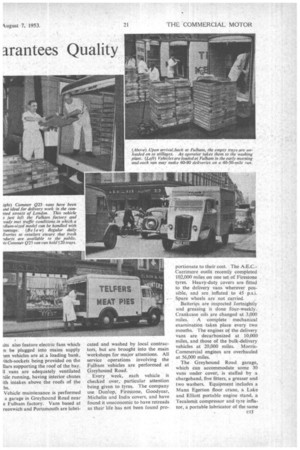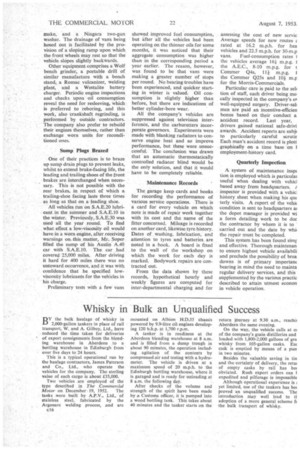24—Hour Ser
Page 50

Page 51

Page 52

If you've noticed an error in this article please click here to report it so we can fix it.
Hantees Quality
Thorough Maintenance of Delivery Vans Ensures that Meat-products Manufacturers' Fleet can Operate at Peak Efficiency
By Alan Smith
EFFICIENT ancillary transport services are vital to manufacturers of perishable foods, and their value is particularly well exemplified by the activities of the fleet of Henry Telfer, Ltd., Lerry House, Lillie Road, Fulham, London, S.W.6. The company, who started work in 1926 and then had three tricycles for the delivery, of their products, now claim to be the largest concern in the world concentrating solely on the manufacture of meat pies and sausage rolls. Pies are made in sizes ranging from the21 oz. Bantam to the 7 lb. Gala, and the company also produce sausages and cakes. Altogether, there are 42 different sales lines.
Volume of Traffic Practically all output is carried away by the company's own vans. Several hundreds of tons of goods are handled weekly, the volume rising to a peak during the winter. Because of the perishable nature of the goods, the company aim to give customers in the south of England a daily service. Stockists are enabled not to over-order by virtue of the reliability . and frequency of the delivery service, and fresh goods can reach customers 24 hours after production. .
The company's activities had to be retracted when war-time restrictions upon the.supply of meat were introduced, but with their impending removal plans have been laid for a re-expansion. At present, the concern run delivery vehicles from Fulham, Greenwich and Portsmouth, the last-mentioned two places being where depots are maintained and supplied from the Fulham factory.
This work entails round-the-clock operation by an A.E.C. Monarch, which tows a Carrimore trailer, and seven Commer Q4 vans, Factory c14 products, after being wrapped, are arranged in trays and on the depotsupply vehicles the trays are carried simply laid one on top of the other. No racking is needed. The Monarch, which makes nightly runs to Portsmouth, can carry 720 trays and each of the other units 460.
.Thirty-nine Morris-Commercial CV11 vans (five of which are reserves), and four Commer Q25 models are used to deliver direct to customers from Fulham. The Cornmers have been found ideal for work in congested areas. There are, in addition, five Austin 10-cwt.. and four Commer Express emergency service vans.: The Morris-Comrr dal and 025 vehicles have racks the cagy withdrawal of tray delivery; a• Morris-Commercial I hold 156 trays and a Q25 120. 7 racking also allows fresh air circulate around the goods in tran TS;venty-two Morris-Commerci. supplemented by three Express va operate from Greenwich, covering rounds in north and east London a parts of Essex and Kent. Deliver from Portsmouth call for f Morris-Commercials and an Aus A40.
Three vehicles shuttle between F barn and Greenwich depot on bi deliveries, the first van leaving I factory at 10 p.m. each day. Bedfo Carrimore articulated outfits are la to be used for this .purpose. trays are unloaded on to stillages a sorted, and the night staff load 1 delivery vehicles so that they can' off early the next day.
Unloading Procedure On return to Fulham, having ea made some 60-80 calls, vehicles I unloaded of empty trays which \ I washed by steam jet. Loading tat place early in the morning, goc being taken either from the prod' tion lines or from cold store. T operations of the bulk vehicles cor entirely under the control of t transport manager, Mr. K. J. Sop A.M.Inst.T., but the driver-salesm of the delivery vans are immediate responsible to the sales manager, Iv J. J. Hall. Mr. Soper is, howevi in charge of the maintenance of , vehicles.
Most of the vehicles have Isk rnand bodywork. The frames are timber, the outer skins of light alit and the interior linings of hardboar The delivery vans have roller shutte at the rear, whilst the bulk vehicl have doors and tailboards. The iits also feature electric fans which n be plugged into mains supply ien vehicles are at a loading bank, +itch-sockets being provided on the liars supporting the roof of the bay. ll vans are adequately ventilated hile running, having interior chutes ith intakes above the roofs of the bs. • Vehicle maintenance is performed a garage in Greyhound Road near e Fulham factory. Vans based at reenwich and Portsmouth are lubri cated and washed by local contractors, but are brought into the main 'workshops for major attentions. All service operations involving the Fulham vehicles are performed at Greyhound Road.
Every week, each vehicle is checked over, particular attention being given to tyres. The company use Dunlop, Firestone, Goodyear, Michelin and India covers, and have found it uneconomic to have retreads as their life has not been found pro
portionate to their cost. The A.E.C.Carrimore outfit recently completed 102,000 miles on one set of Firestone tyres. Heavy-duty covers are fitted to the delivery vans 'wherever possible, and are inflated to 45 p.s.i. Spare wheels are not carried.
Batteries are inspected fortnightly and greasing is done four-weekly. Crankcase oils are changed at 3,000 miles. A complete mechanical examination takes place every two months. The engines of the delivery vans are decarbonized at 10,000 miles, and those of the bulk-delivery vehicles at 20,000 miles. MorrisCommercial engines are overhauled at 56,000 miles.
The Greyhound Road garage, which can accommodate some 30 vans under cover, is staffed by a chargehand, five fitters, a greaser and two washers. Equipment includes a Mann Egerton floor crane, a Lake and Elliott portable engine stand, a Tecalemit compressor and tyre inflator, a portable lubricator of the same make, and a Niagara two-gun washer. The drainage of vans being hosed out is facilitated by the provision of a sloping ramp upon which the front wheels may rest so that the vehicle slopes slightly backwards.
Other equipment comprises a Wolf bench grinder, a portable drill of similar manufacture with a bench stand, a Romac vulcanizer, welding plant, and a Westalite battery charger. Periodic engine inspections and checks upon oil consumption reveal the need for resleeving, which is preferred to reboring, and this work, also crankshaft regrinding, is performed by outside contractors. The company also prefer to rebuild their engines themselves, rather than exchange worn units for reconditioned ones.
Sump Plugs Brazed One of their practices is to braze up sump drain plugs to prevent leaks, whilst to extend brake-facing life, the leading and trailing shoes of the front brakes are interchanged when necessary. This is not possible with the rear brakes, in respect of which a trailing-shoe facing lasts three times as long as that on a leading shoe.
All vehicles run on S.A.E.20 lubricant in the summer and S.A.E.10 in the winter. Previously, S.A.E30 was used all the year round. To find what effect a low-viscosity oil would have in a worn engine, after receiving warnings on. this matter, Mr. Soper filled the sump of his Austin A.40 car with S.A.E.10. The car had covered 25,000 miles. After driving it hard for 400 miles there was no untoward occurrence, and it was with confidence that he specified lowviscosity lubricants for the vehicles in his charge.
Preliminary tests with a few vans showed improved fuel consumption, but after all the vehicles had been operating on the thinner oils for some months, it was noticed that their aggregate consumption was higher than in the corresponding period a year earlier. The reason, however, was found to be that vans were making a greater number of stops per round. No bearing troubles have been experienced, and quicker starting in winter is valued. Oil consumption is slightly higher than before, but there are indications of better cylinder-bore wear.
All the company's vehicles are suppressed against television interference, and the carburetters incorporate governors. Experiments were made with blanking radiators to conserve engine heat and so improve performance, but these were unsuccessful. The conclusion was drawn that an automatic thermostatically controlled radiator blind would be the only solution, and that it would have to be completely reliable.
Maintenance Records The garage keep cards and books for recording the performance of various service operations. There is a card for every vehicle on which note is made of repair work together with its cost and the name of the fitter concerned. Mileage is recorded on another card, likewise tyre history. Dates of washing, lubrication, and attention to tyres and batteries are noted in a book. A board is fixed to the wall of the workshop on which the work for each day is marked. Bodywork repairs are contracted out.
From the data shown by these records, hypothetical hourly and weekly figures are computed for inter-departmental charging and for assessing the cost of new servic Average speeds for new routes .1 rated at 16.2 m.p.h. for hea vehicles and 22.5 m.p.h. for 30-m.p vans. Fuel-consumption rates I the vehicles average 16/ m.p.g. i the A.E.C., 8-10 m.p.g. for t Commer Q4s, 11/ m.p.g. 1 the Commer Q25s and 10i m.p for the Morris-Commercials.
Particular care is paid to the seli tion of staff, each driver being me. catty inspected in the company's ol well-equipped surgery. Driver-sal' men are paid an incentive-efficien bonus based on their conduct a accident record. Last year, drivers gained national safe-drivi awards. Accident reports are subjt to particularly careful scrutir Each man's accident record is plott graphically on a time base on employment-history card.
Quarterly Inspection A system of maintenance inspc tion is employed which is particulai useful when dealing with vehicl based away from headquarters. inspector is provided with a vehicl history sheet when making his qui terly visits. A report of the vehic condition is sent to headquarters al the depot manager is provided wi a form detailing work to be dor the contractor by whom it is to carried out and the date by whi4 the repair must be completed.
This system has been found simr and effective. Thorough maintenan to ensure highest vehicle availabili and preclude the possibility of brea downs is of primary importanc bearing in mind the need to mainta regular delivery services, and this supplemented by the various practic described to attain utmost econon in vehicle operation.
























































































